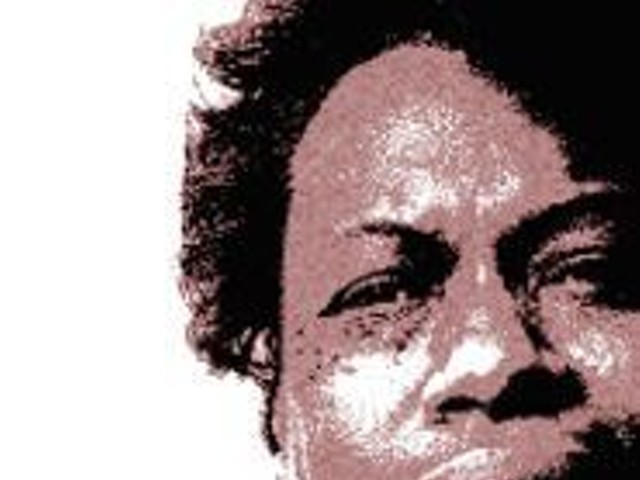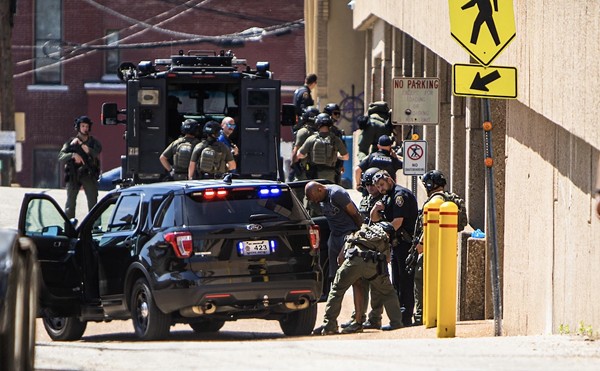Her club, the Hi-Pointe Lounge, is no longer a Camel Club. "Oh God," she says despondently, "I always knew it would come to an end. Nothing like that lasts forever. I mean, six years."
It's almost as if there has been a death in the family. "I should put a black sheath around the building like they did at Capitol Records when George Harrison died," Andris laments. "I'm actually going to send them a card: 'Thanks for the memories.'"
Those memories are of a marketing program that provided Andris and more than 50 other area bars -- not to mention many hundreds across the United States -- with free Camel products and an annual stipend she spent to bring big-name music acts to the club.
The Camel Club program, a mainstay of nightlife nationwide since 1997, was laid to rest on April 2, the most prominent casualty of parent company R.J. Reynolds' shuttering of its Lifestyle Media Group, which managed all of the tobacco giant's promotional field-marketing activities. Gone is the avalanche of accoutrements Camel had provided to bars and smokers.
The clubs, to put it mildly, are jonesin'.
Camel Clubs were part of a vast campaign to reposition the cigarette in the minds of smokers. Before the program's kickoff, the brand was decidedly unhip. "The goal was to reposition Camel, to create brand awareness, because Camel at the time was perceived as Grandpa's cigarette," asserts an industry insider who declined to be identified in print. "They basically threw a bunch of money at totally gutting the image of Camel as far as how it's perceived."
And they did it in a big way. With an annual national budget of more than $10 million, Camel injected itself into every aspect of the smoking experience in bars, emblazoning all available surfaces with the brand's logo. Napkins, matches and ashtrays, once blank, now bore the Camel mark -- and were provided free of charge to participating businesses. In exchange, the bars agreed to sell only Camel smokes delivered by field reps. Vending machines, on the wane as a result of stiff laws prohibiting sales of tobacco to minors, were pulled; in their place sprouted behind-the-bar kiosks that stocked Camel products only.
This was a problem among brand loyalists in the beginning, says Andris, whose bar was one of the first to sign up with Camel. But not for long. "People got used to that real quick," she says. "At first it seemed like a real deterrent, but it wasn't. If somebody feels that strongly about it, they just walk across the street to buy a pack. It was well worth all the free goodies you got." Andris estimates that the free supplies added up to $6,000 to $7,000 annually.
"I'm going to have to do a cost analysis to figure all this out," chimes in Tom Gray, co-owner of the nightclub Velvet. He never had to before, he adds, because it was all free.
Cost analysis isn't the half of it. Explains Bob Krekeler, CEO of Mound City Industries Inc., one of the city's largest cigarette distributors: "The promotional companies would buy from someone like ourselves, and then they had their own people who would go out to these bars and make sure they got the product. The problem is that most of the bars are not large enough to get a direct shipment from a wholesaler."
Krekeler figures bar owners may now have to resort to either buying their smokes retail and reselling them (which is illegal) or picking them up at a wholesale warehouse.
"We'll be at liberty to buy any kind of cigarettes we want from any place we want, but that's more hassle for me -- an extra thing that I have to do every week now," Andris says. "Before, I'd get on the phone with Camel, order my cigarettes, and they'd bring them in."
They'd also deliver cash. The biggest perk of being a Camel Club was the money Camel simply gave to venues, the lion's share of which was spent to book and promote music acts that would otherwise have been too high-priced for the clubs. Last year, with part of the $9,000 she got from Camel, Andris funded the Hi-Pointe's annual Beatle Bob Birthday Bash. Previous funding also went to a Los Straitjackets/Big Sandy and His Fly-Right Boys double bill. With his allotment, Tom Gray booked big-name DJs Seb Fontaine, Tall Paul and Bad Boy Bill at Velvet. The Way Out Club brought in rockabilly legend Hasil Adkins. Camel funded 80 percent of the twice-yearly Washington Avenue Beat Festival, a brouhaha that brings top national and local electronic acts to a half-dozen clubs downtown.
Tom White, manager of the Complex, a gay dance club on Chouteau, says his club received $12,500 from Camel last year. "We had some really great talent throughout the years due to them. I would say thanks to the community for being there, through the Camel money. And I would lose my ass on every event, but since it was Camel's money, it wouldn't matter." White says he brought in, among others, singers Taylor Dayne, Ultra Nat and Sonique. For the Complex, he says, "it was five great years."
And without tobacco money -- about $250,000 annually in St. Louis -- none of it would have been feasible.
"Nationally, Camel funded so many venues that funded so many acts," says Andrew Mullins, head of the St. Louis office of Group III Marketing, which has operated the Camel Club campaign in 30 cities, including St. Louis, since its inception. "The local DJ kid, if he played down at Velvet, might make 50 bucks, but if it's a Washington Avenue Beat Festival, he'd get paid what he should get paid, and that's because of Camel. Hot House Sessions on a Wednesday night might make one amount, and on a corporate-funded gig on a weekend they might make five times that. [Popular house DJ] Donald Glaude will get less booking because bars will not be able to afford his talent fees."
Without the corporate sponsorship, Mullins predicts, up-and-coming acts will suffer more downtime.
Marc Buxton opened Group III's St. Louis office in late 1996, back when the firm was called KBA Marketing. "It allowed venues to book up, to break talent," explains Buxton, who left the firm two years ago. "You'd take a chance on it because you weren't spending a dime. You'd bring in bigger talent; you would do it because you had X amount of money you figured was the nut for your show, and you figure, 'Well, I don't dig into the bar, so here's what my door's gotta be.' St. Louis isn't known for charging $10 and $20 covers, so it allowed them to book acts that never would have played the market."
Buxton seconds Mullins' assessment of what's to come: "You'll see less A-level talent because, economically, it just doesn't work."
Andris used some of her annual Camel cash to compensate bands she liked: "Bands are forced to live in such poverty. It's so hard for me to pay anybody anything that, to be honest, I always kind of overpay the bands when I've got Camel money. I actually pay them what I think they should be getting -- what bands should make and what comes through the door are two different things. So a band that I would normally pay $200 with some back end, if I had Camel money I might pay them $600."
Fred Friction, owner of Frederick's Music Lounge, used his money a bit more freely. "Ours was never specifically earmarked for bands. It was presented to us in that manner -- that we could use it for events that we would otherwise never be able to afford. But we used it to pay utility bills, or when the licenses were due." The only negative, he says, was living with the knowledge of where the money came from: "Having to sleep with that on our conscience, the commercialism of it. But then we decided that, well, we can whore ourselves out a little bit."
Tom Gray says the Washington Avenue Beat Festival will continue and that he's looking for other sponsors. "It's going to make it a little tougher without [Camel] around," he concedes. "We're going to miss that whole resource."
It was an impressive, multifaceted resource, to be sure. The goal of the Camel Club campaign was to marry live music to the brand, to snare smokers where they spend their nighttime hours. And from the start, Camel was an overwhelming presence. The marketing firm printed thousands of full-color rave-style Camel fliers and piled them at clubs. They took out full-page ads in newspapers like this one, using the space to profile Camel bars, their bartenders and the bands they booked. And they sent out battalions of field reps toting black bags, doling out free smokes to Camel Club bartenders and patrons alike.
"They were real good about that," Friction reflects. "Especially with the staff. They'd get three or four packs for free."
Over the past few years, as the court judgments have mounted, tobacco companies' efforts at image repair have increasingly given way to downright panic about money. Most recently, in a decision last month, Madison County Circuit Court Judge Nicholas Byron awarded plaintiffs $12 billion in damages after he found cigarette maker Philip Morris liable for failing to inform consumers that its "light" cigarettes were as harmful as their full-tar counterparts. (One industry analyst, who declined to be identified in print, predicts that Byron's move "is going to bankrupt the industry.")
"The business dynamic has obviously been changing in the last six months," says R.J. Reynolds spokeswoman Maura Payne. "It is an extremely competitive category. There has been an increase in competitive spending between the manufacturers. State excise taxes have increased dramatically in 2002, and many are proposed to be increased again in 2003, so the competitive marketplace has become even more so."
Corporate-speak, to be sure, but it's not hard to read between the lines. "Companies are having to maximize every opportunity for efficiency, in terms of their marketing support," Payne says. "We used to sponsor events in nightclubs and bars because they are smoker-friendly, clearly adult environments. Because we want to -- as most companies do -- maximize our efficiency and effectiveness, we are doing some reallocations."
The insider quoted earlier maintains that the cut is the direct result of an impending payment R.J. Reynolds is scheduled to make as part of the 1998 settlement agreement tobacco companies reached with state governments to settle health-related lawsuits. "It's coming up on R.J. Reynolds' turn, and their sales are down," the source says, "so there's no way they justify outlaying this much money on the program at this point."
Payne denies that the Camel Club's demise is related to the payment. She does, however, confirm that the money -- R.J. Reynolds' annual share of the $206 billion payment -- is about to come due: "Every company has a payment due once annually, and it's all on the same day." That day? "The fifteenth of April."
Still, the abrupt cutoff surprised everyone. Group III had just hired more employees -- who, along with the rest of the Group III staff in St. Louis, will now be laid off. Clubs had already scheduled gigs that were to be paid for with Camel money. The Hi-Pointe's Lisa Andris threw her birthday bash this past weekend at the club; she'd planned to award the winner of a go-go-girl contest a grand prize of $300 in Camel-supplied cash. When R.J. Reynolds snuffed the funding, though, the company did so immediately, and without prior notice. Andris paid last weekend's expenses out of her own pocket.
"The bottom line is," says Marc Buxton, "in St. Louis, and in many markets -- Kansas City, Memphis, many Midwestern markets -- the scene was bolstered by this program. And it would have never gotten to the level that it did without the help of that sponsor. It's going to be a huge, huge hole."





